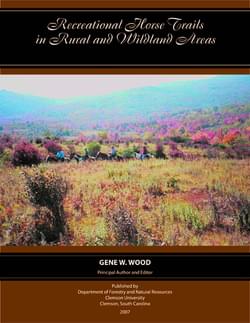




By Dr. Gene Wood
American Trails Magazine editor, Stuart Macdonald, reviews Dr. Wood's equestrian trail book.

All trails interests can learn from equestrian trail book.
The author states that the purpose of the book is to guide land managers and equestrian trail users in design, construction, and maintenance of horse trails in a manner that harmonizes with the surrounding ecosystem and landscape values. The three goals for trails are to be safe for users, ecologically sound, and economically sustainable.
This theme of creating sustainable trails that are sensitive to the environment and habitats through which they pass runs throughout the book. In the opening chapter the author acknowledges that "Among nonmotorized uses of trails, recreational horse use if the most frequently criticized for ecosystem damage." His goal is for trail planners and activists to become proficient in natural ecosystem components and processes. To this end the first chapter is not about trail planning, or design, but about soils, watersheds, and habitats.
Whatever our specific trail activities and interests, we are all liable for criticism for impacting and degrading the environment. The mission of American Trails is to provide more tools for trail supporters to learn the best practices as well as the benefits of trails. Working together, we can create a legacy of trails that support the long-term goal of planning, building and managing better trails.
The book goes into detail on all the major topics of trail work, including design, structures, facilities, with an emphasis on horse-specific issues. Contributing authors from several agencies and organizations provide material on topics such as bridges, Geographic Information Systems, and trail management. Many photos and graphics illustrate the topics.
The book is in full color with 256 numbered pages covering 14 chapters and 6 appendices that contain 214 figures and 23 data tables.
About the Author
Dr. Gene W. Wood is Professor Emeritus, Clemson University Dept. of Forestry and Natural Resources. This book was published in 2007 by the Department of Forestry & Natural Resources, Clemson University, Clemson, SC and funded by the Federal Highway Administration's Recreational Trails Program in cooperation with the American Horse Council and Clemson University.